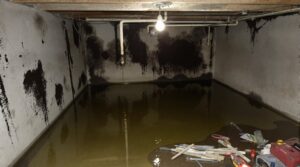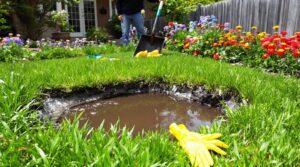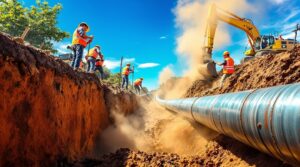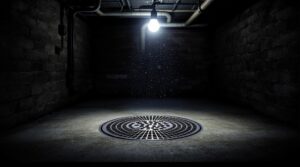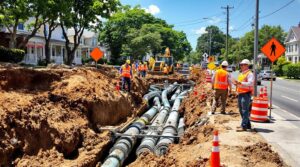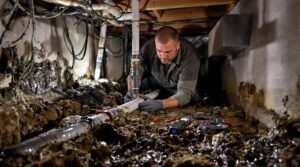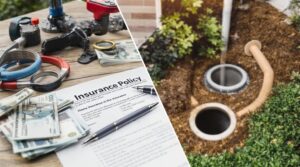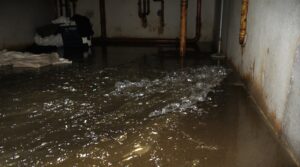Clearing a main sewer line clog requires proper safety equipment and specific tools, including professional-grade drain cleaning machines and protective gear. Initial steps involve identifying the clog location through multiple fixture symptoms and accessing the cleanout fitting. Natural solutions like boiling water or vinegar/baking soda mixtures can dissolve minor blockages, while stubborn clogs need mechanical intervention with a plumbing snake or hydro jetting. Professional expertise becomes essential when DIY methods prove insufficient or unsafe to attempt.
Key Takeaways
- Start by pouring boiling water down drains to dissolve water-soluble clogs and break down organic matter buildup.
- Create a natural cleaning solution using vinegar and baking soda to help break down grease and organic blockages.
- Insert a plumbing snake or auger through the main cleanout fitting, slowly feeding it into the pipe to clear obstructions.
- Identify main line clogs by checking if multiple fixtures back up simultaneously or water appears in tubs during washing.
- Avoid using harsh chemical cleaners as they can damage pipes; instead, rely on mechanical methods and natural solutions.
Understanding Main Sewer Line Clogs and Their Warning Signs
A clogged main sewer line poses significant risks to both property and health, requiring immediate attention and proper diagnosis.
Accurate clog identification begins with recognizing distinct warning signs that indicate a main line blockage rather than a simple fixture clog. Key indicators include multiple plumbing fixtures backing up simultaneously, particularly when toilets, showers, and sinks experience drainage issues at the same time.
The presence of sewage odors around fixtures, combined with gurgling toilets and slow-draining water throughout the house, strongly suggests a main line obstruction.
Another telltale sign is water backing up into bathtubs or showers when running the washing machine. Regular inspection and maintenance can help identify old deteriorating pipes before they collapse and create severe blockages.
These symptoms often result from common causes such as tree root infiltration, grease accumulation, or foreign object blockages.
Understanding these warning signs enables homeowners to differentiate between localized clogs and more serious main line issues, ensuring appropriate intervention before significant damage occurs.
Essential Tools and Safety Equipment for DIY Sewer Line Clearing
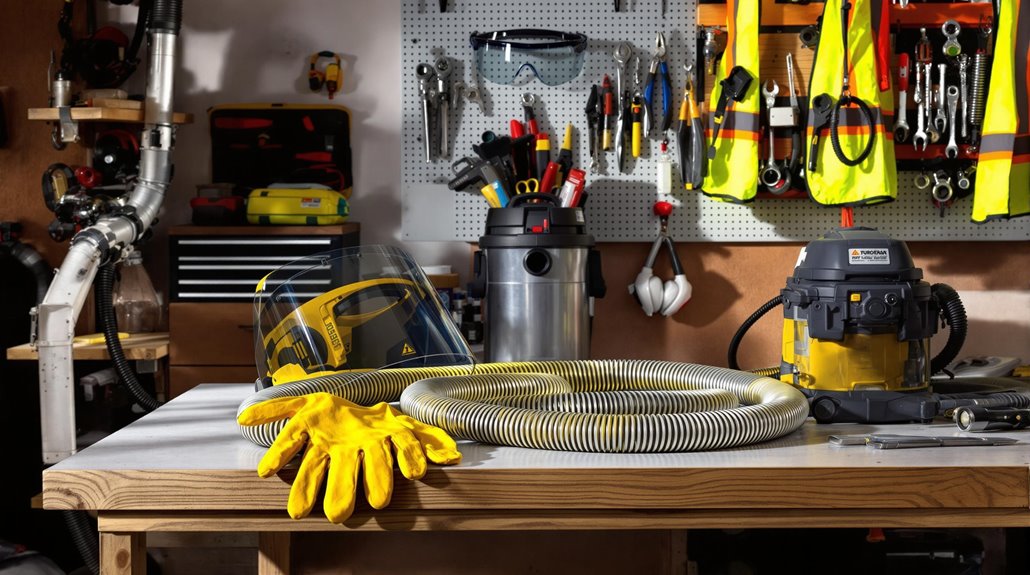
Successful DIY sewer line clearing requires both specialized equipment and extensive safety gear to protect operators from potential hazards while effectively addressing blockages. The primary tools needed include professional-grade sewer drain cleaners with variable speed motors, cutting attachments for different blockage types, and manual implements such as plungers and drain augers. The machine must be plugged into outlets and checked for proper electrical connections before operation.
- High-quality drain cleaning machines must be equipped with durable cables and appropriate cutting tools, including root cutters, grease tools, and retrieval attachments.
- Protective equipment including heavy-duty gloves, safety goggles, and proper work clothing is essential for operator safety.
- Regular tool maintenance and adherence to safety guidelines help prevent equipment failures and workplace accidents.
- Safety preparation includes proper worksite setup with warning cones, thorough assessment of the clog's severity, and understanding equipment limitations.
Operators must also maintain awareness of when a job exceeds DIY capabilities and requires professional intervention to avoid system damage or personal injury.
Step-by-Step Methods to Clear Your Main Sewer Line

When faced with a main sewer line clog, homeowners must follow a systematic approach that progresses from basic, non-invasive methods to more aggressive mechanical solutions. Initial plumbing techniques should begin with pouring boiling water down the drain to dissolve water-soluble clog causes, followed by the vinegar and baking soda method, allowing the chemical reaction to break down organic matter and grease buildup.
If these methods prove insufficient, mechanical interventions become necessary. Homeowners should locate the cleanout fitting and employ a plumbing snake or auger to physically break through obstructions. Regular maintenance with enzyme cleaners monthly can help prevent future clogs from forming. The snake must be inserted carefully and rotated to effectively clear blockages.
For persistent clogs, hydro jetting may be required, utilizing high-pressure water to scour the pipe walls clean. Throughout the process, it's vital to avoid harsh chemical cleaners that can damage pipes.
If DIY methods fail to resolve the blockage, professional intervention should be sought to prevent potential system damage.
Common Mistakes to Avoid When Clearing Sewer Clogs
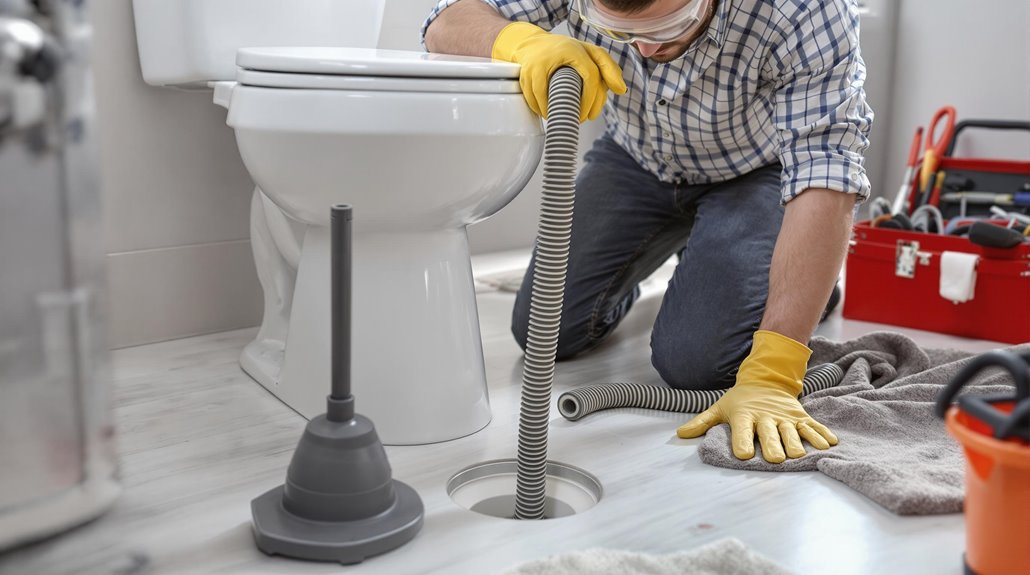
While clearing main sewer line clogs requires proper techniques, many homeowners make preventable mistakes that can worsen blockages and damage plumbing systems.
Common misconceptions about DIY drain cleaning often lead to emergency solutions that cause more harm than good.
- Excessive use of chemical cleaners poses significant risks, as these products can corrode pipes, especially copper ones, and release harmful fumes into living spaces.
- Using improvised tools like coat hangers or incorrect plumbing equipment can push clogs deeper into the system or damage pipe walls, resulting in costly repairs.
- Underestimating the severity of blockages frequently leads homeowners to delay professional assessment, potentially allowing minor issues to develop into major problems.
- Neglecting proper maintenance and attempting unsafe cleaning methods without understanding pipe materials or proper techniques can compromise the entire plumbing system's integrity and create hazardous conditions.
Preventive Maintenance Tips for a Healthy Sewer System
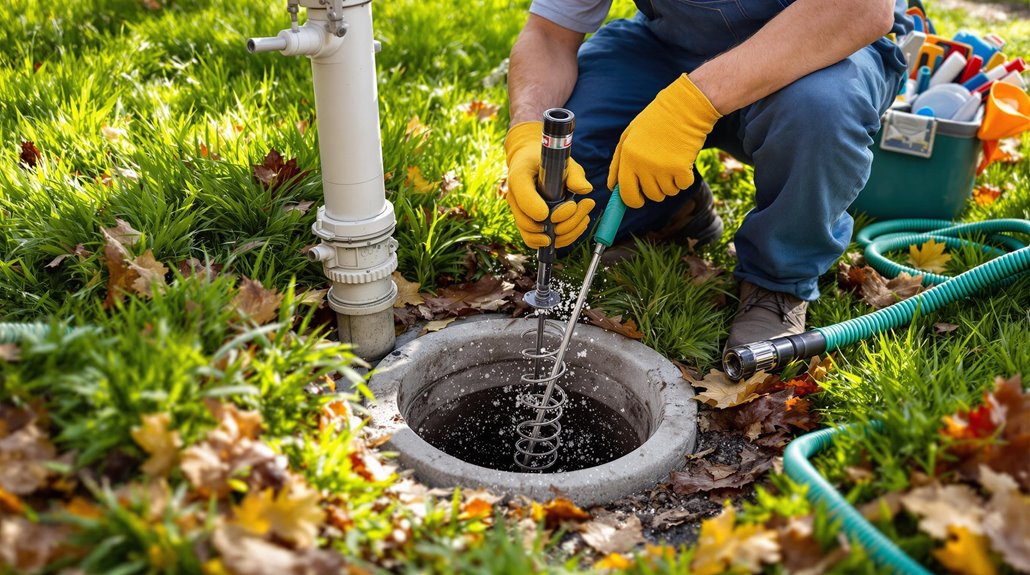
Maintaining a healthy sewer system requires a thorough preventive maintenance strategy that combines regular inspections, proper waste disposal practices, and professional servicing. Homeowners should implement biannual sewer inspections using professional high-pressure water jet cleaning and camera technology to detect potential issues before they escalate into major problems.
Important preventive tips include installing sink strainers, avoiding disposal of fatty substances and food waste, and guaranteeing only appropriate materials enter the system. Regular visual inspections of visible pipes can identify early signs of damage, while seasonal maintenance helps prevent tree root intrusion.
For homes with septic systems, scheduled pumping and component inspections are essential. Professional sewer inspections should include camera evaluations to detect sags, fractures, or blockages.
Installing backwater prevention valves and maintaining proper tree root control measures further protect the system's integrity. Educating household members about appropriate waste disposal practices guarantees long-term system health and prevents costly repairs.
The Benefits Of Consulting A Public Adjuster

When dealing with significant sewer line damage that requires an insurance claim, consulting a public adjuster provides valuable expertise in maneuvering complex claims processes and securing fair compensation.
Public adjusters conduct thorough, objective assessments of sewer damage while documenting all evidence needed to support maximum claim value. Their professional advocacy and negotiation skills typically result in higher settlement amounts compared to self-filed claims, while streamlining the entire claims process for property owners. Studies show that engaging public adjuster services can increase claim settlements by up to 500% for non-catastrophic property damage situations.
Expertise In Insurance Claims
The expertise of a public insurance adjuster can be invaluable when dealing with sewer line damage claims.
These licensed professionals possess extensive knowledge of insurance policies and employ proven claims strategies to maximize settlements. Their understanding of complex policy language and negotiation tactics guarantees policyholders receive fair compensation for covered damages.
- Public adjusters identify all compensable damages through thorough policy interpretation
- They handle all communications with insurance companies, eliminating policyholder stress
- Their contingency-based payment structure aligns with successful claim outcomes
- Professional negotiation skills counter insurance company minimization tactics
With public adjuster fees typically capped at 10% of the total settlement, their services often lead to significantly higher payouts than settling directly with insurance companies.
Objective Damage Assessment
Professional damage assessment by a licensed public adjuster provides policyholders with an impartial evaluation of sewer line damages and associated losses.
Through systematic claims investigation and documentation, adjusters compile extensive evidence including photographs, videos, and written reports detailing the extent of damage.
The adjuster conducts thorough damage evaluation through on-site inspections and environmental assessments to determine the full scope of the problem.
This independent analysis guarantees accurate loss estimation and proper documentation for insurance claims.
Public adjusters utilize their expertise to advocate for fair settlements, negotiating with insurance companies on behalf of property owners.
Their systematic approach helps establish liability and supports the claim valuation process, ultimately protecting the policyholder's interests while maintaining compliance with regulatory requirements.
Working on a contingency fee basis, public adjusters typically charge 5-20% of the final settlement amount, making their services accessible to property owners facing significant damage claims.
Streamlined Claim Process
Through systematic claims management, public adjusters significantly streamline the filing process for sewer line damage claims while maximizing potential settlements. Their expertise in efficient processing guarantees thorough documentation and accurate assessment of damages, leading to faster claim resolutions and reduced stress for property owners.
- Public adjusters implement automated processes and real-time communication systems to expedite claim submissions.
- Professional documentation handling and expert advocacy minimize delays and potential errors.
- Advanced data analytics tools help identify and address potential issues early in the claims process.
- Streamlined communication channels between all parties guarantee efficient coordination and faster settlements.
This systematic approach to claims management not only accelerates the resolution process but also guarantees regulatory compliance while maintaining the highest standards of accuracy and professionalism throughout the entire procedure.
Higher Claim Payouts & Settlements
Beyond streamlined processes, engaging a public adjuster consistently leads to markedly higher claim settlements for property owners facing sewer line damage.
Studies demonstrate significant increases in compensation, with catastrophic claims showing up to 747% higher payouts when handled by public adjusters.
These professionals employ sophisticated claim strategies and negotiation tactics to maximize settlements. Their expertise in policy interpretation allows them to identify overlooked damages and present thorough documentation to insurance carriers.
Research by FAPIA confirms the financial advantage, with public adjuster-assisted claims averaging $22,266 compared to $18,659 for unassisted claims.
While public adjusters typically charge between 5-20% of the settlement, their ability to secure substantially higher payouts often justifies this investment, particularly in complex sewer line damage scenarios.
Understanding coverage and deductibles is essential before filing a claim, as it helps determine the viability of pursuing insurance compensation.
About The Public Claims Adjusters Network (PCAN)
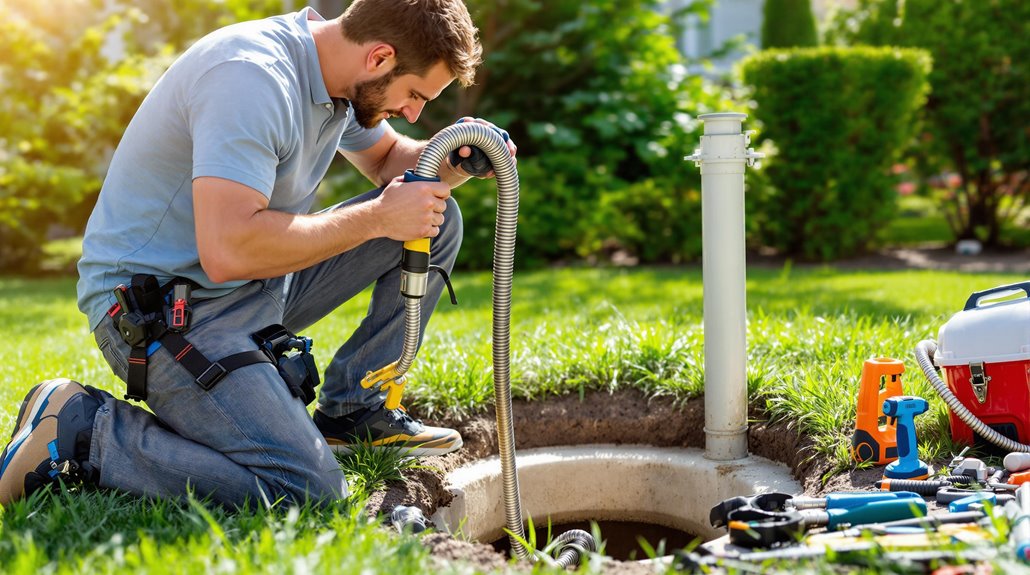
Insurance claim management networks like the Public Claims Adjusters Network (PCAN) operate alongside established organizations such as 1800Adjusters and NICA to provide extensive claim handling services for property owners.
These networks employ professional claims adjusters who specialize in maximizing settlement outcomes through strategic claim negotiation strategies.
- Professional adjusters conduct thorough damage assessments using industry-standard estimating software to document all aspects of property damage.
- Claims adjuster roles include meticulous documentation preparation, evidence gathering, and direct negotiation with insurance carriers.
- Networks maintain compliance with industry regulations while pursuing maximum claim settlements, often achieving 300-400% higher payouts.
- Adjusters provide detailed support throughout the claims lifecycle, from initial assessment through final settlement.
These networks guarantee property owners receive expert representation during the claims process, leveraging extensive experience and proven methodologies to secure fair compensation for property damage and related expenses.
All PCAN members must demonstrate 4+ star reviews and at least three years of business experience before being accepted into the network.
Frequently Asked Questions
Can Tree Root Killer Damage My Septic System or Garden?
Proper application of tree root killers is essential for septic safety. While effective against roots, excessive use can harm beneficial bacteria in septic systems and potentially damage surrounding garden vegetation.
How Often Should I Schedule Professional Sewer Line Inspections?
Professional sewer line inspection frequency depends on property age. Schedule inspections every 3-5 years for newer homes, annually for older properties, and immediately when issues arise or large trees threaten lines.
What Temperature Water Is Too Hot for PVC Pipes?
Water temperatures exceeding 140°F (60°C) pose safety risks for PVC pipes, potentially causing structural damage. Maximum recommended operating temperature is 140°F, with ideal performance below 104°F (40°C) for continuous use.
Does Homeowner's Insurance Cover Damage From DIY Sewer Line Clearing?
After a homeowner's DIY hydro-jetting attempt cracked their main line, insurance denied coverage. Most policies exclude DIY sewer clearing damage, requiring supplemental coverage or professional service to maintain protection.
Which Cleaning Products Can Be Safely Mixed for Clearing Clogs?
No cleaning products should be mixed for clearing clogs. Safe mixtures are limited to baking soda with salt, while single-product solutions or professional assistance remain the most effective solutions.
References
- https://www.angi.com/articles/clear-main-sewer-line-clog-yourself.htm
- https://www.mdsewer.com/blog/how-to-clear-a-main-sewer-line-clog-yourself
- https://www.choosekobella.com/blog/unclog-sewer-line-guide/
- https://davisplumbingpro.com/blog/how-clear-main-sewer-line-clog/
- https://edennisacinc.com/blog/clogged-sewer-line/
- https://trusteyman.com/blog/what-causes-the-main-sewer-line-to-clog/
- https://www.gallegosplumbing.com/blog/2021/august/everything-to-know-about-how-to-clear-the-main-s/
- https://www.thespruce.com/signs-of-a-sewer-drain-clog-2718943
- https://www.arcoplumbing.com/causes-of-main-sewer-clogging-warnings-signs-to-look-out-for/
- https://www.youtube.com/watch?v=Z_fbYfsecp0
